What key decisions influence whether a community thrives?
Most early Iowa settlers lived on farms. Some, however, were merchants, lawyers, doctors, newspaper publishers, ministers or craftsmen who lived in the new towns springing up across the prairie. Not all the towns survived. Some never attracted many people and others lost population when conditions changed. The result was Iowa “ghost towns” that exist across the state.
Iowa Ghost Towns
Most early towns came into existence to serve the surrounding farm population. When a trip to town could take several hours, farmers wanted services and supplies close at hand, and towns sprang up every five to six miles apart. The coming of the railroads in the 1870s and 1880s both helped and hindered Iowa. Towns along the rail lines became trading centers where merchants could receive goods from the East and farmers could sell their cattle and hogs for shipment to eastern cities. Towns that had no railroad connection lost customers and usually became ghost towns. Sometimes the railroads even created towns due to the fact that steam engines needed coal and water. This impacted western Iowa especially as rail lines arrived before major waves of population.
Some towns were created with a special purpose. This is especially true of those based upon coal mining, a big industry in Iowa in the late 19th and early 20th centuries. The railroads again were a major factor because trains were the main buyers for Iowa coal. Many small coal mines sprang up in southeastern and central Iowa. Miners and their families occupied cheap housing nearby, and the rail company sometimes operated general stores and other services for their workers. When the coal ran out in the mine, the mine closed and the miners moved away. Sometimes the houses and other buildings were loaded onto trains and moved to a nearby location where a new mine was opening up.
Buxton
The town of Buxton in southeastern Iowa was unique in that a majority of its residents were African American. The Consolidation Coal Company worked for the Chicago and Northwestern Railroad. Having a hard time recruiting white miners, Consolidation Coal sent agents to southern states to hire African-American workers. In 1873, it founded the town of Buxton and opened nearby mines. It grew quickly and, according to one source, became the largest coal town west of the Mississippi. In the 1905 census, the town boasted 2,700 African American people and 1,991 white people. The town supported African-American doctors, lawyers and other professionals, and an African-American YMCA with a gymnasium, an indoor swimming pool and many programs for Buxton residents. The town was proud of its baseball team, the Buxton Wonders. White residents included immigrants from Sweden and elsewhere, and they existed peacefully with the African-Americans throughout the community’s history.
Buxton coal production peaked during WWI but afterward, mechanization and conversion of train engines to diesel fuel decreased the demand for coal. Several severe fires ravaged the community and the mines. By 1919, Buxton’s population had declined to only 400. The last mine closed in 1927. Residents moved away but fondly remembered their Buxton days. Many African Americans moved to Des Moines or Waterloo. Very little physical evidence of the town remains today.
There have been many articles and several books written about this unique African-American experience in rural Iowa. While it is only one of Iowa’s many ghost towns, it is probably the most famous.
Supporting Questions
How was Buxton a unique community?
- Benjamin C. Buxton, Founder of Buxton, Iowa, Date Unknown (Image)
- Postcard View of Center Street in Buxton, 1908 (Image)
- Panoramic View of Buxton, 1910 (Image)
- Postcard Showing Buxton Coal Bank in Shaft of #12 Mine, 1910 (Image)
- Postcard of Miner with Mule-Drawn Cart in a Shaft of Buxton’s #12 Mine, 1910 (Image)
- Monroe Mercantile Company Opening, 1911 (Image)
- Monroe Mercantile Company Interior, 1911 (Image)
- Monroe Mercantile Company Employees, 1911 (Image)
- Map of Bluff Creek Township (Buxton), 1919 (Map)
In what ways did Buxton prosper?
- Buxton Wonders Baseball Team, 1915 (Image)
- Interview of Paul Wilson, Born in Buxton, May 13, 1992 (Document)
- “Back to Buxton,” July 1, 2009 (Document)
What caused Buxton to turn into a ghost town?
- Aftermath of Explosion in Buxton’s #12 Mine, Date Unknown (Image)
- "Buxton Review" in the Iowa State Bystander, June 26, 1914 (Document)
- "As I Remember" by Minnie London, 1940 (Document)
- Buxton: Work and Racial Equality in a Coal Mining Community, 1987 (Document)
| Buxton: A Lost Utopia Source Set Teaching Guide |
| Printable Image and Document Guide |
Benjamin C. Buxton, Founder of Buxton, Iowa, Date Unknown
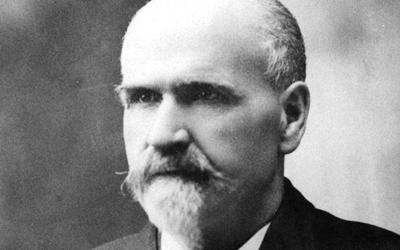
Description
Benjamin Buxton was the namesake of and main planner of the town of Buxton. Benjamin Buxton took over as superintendent of Consolidation Coal Company from his father, John Buxton, in 1896, when he was just 25 years old, until 1909. The town of Buxton, established in 1900,…
Postcard View of Center Street in Buxton, 1908
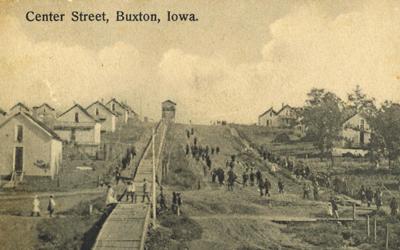
Description
This photograph, featured on a postcard, shows many people seen at a distance walking down “Center Street” in Buxton, Iowa, in 1908. Also called “coal chute hill," coal was moved from railroad cars at the bottom of the hill to the coal conveyor and chute at the top of…
Panoramic View of Buxton, 1910
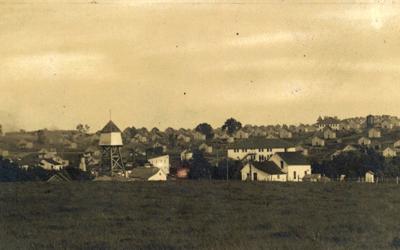
Description
This “Panoramic View of Buxton, Iowa” was photographed in 1910. The image shows two water towers, a few two-story buildings, dozens of identical houses, along with streets of the town. Since Buxton was designed and built by the Consolidation Coal Company to be a central…
Postcard Showing Buxton Coal Bank in Shaft of #12 Mine, 1910

Description
An unknown photographer captured this photograph inside Buxton #12 mine showing pieces of shale and coal that miners were working on moving in 1910. Miners entered the shaft with an empty cart and were paid based on the amount of coal that they brought out at the end of the…
Postcard of Miner with Mule-Drawn Cart in a Shaft of Buxton’s #12 Mine, 1910
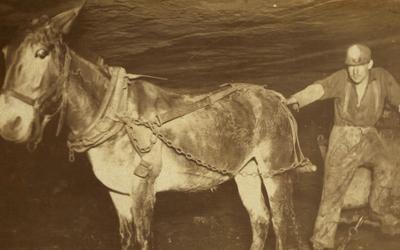
Description
An unknown photographer captured this image that shows a miner in 1910 with mule-drawn coal cart in the shaft of mine #12 at Buxton, Iowa. In his interview, Paul Wilson remembers how mules and mine cars were used…
Monroe Mercantile Company Opening, 1911

Description
Monroe Mercantile was the Consolidation Coal Company’s company store. The original Monroe Mercantile building was destroyed by fire on February 21, 1911. By March 21, 1911, the construction of the new company store was underway, and they held the grand opening of the second…
Monroe Mercantile Company Interior, 1911
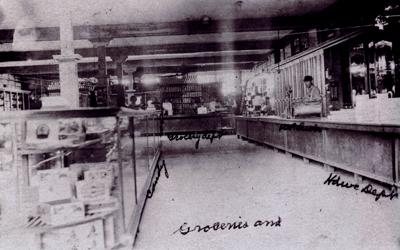
Description
Monroe Mercantile was the Consolidation Coal Company’s company store. It had a wide variety of products and is reported by some to have had fair prices and others to have been higher priced. The original Monroe Mercantile building was destroyed by fire on February 21, 1911.…
Monroe Mercantile Company Employees, 1911
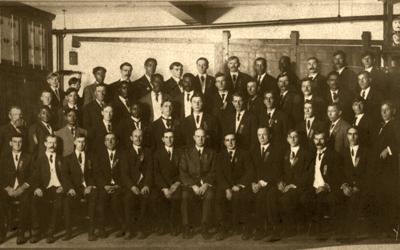
Description
The photograph shows employees from Monroe Mercantile, which was the Consolidation Coal Company’s company store. It had a wide variety of products and is reported by some to have had fair prices and others to have been higher priced. The original…
Map of Bluff Creek Township (Buxton), 1919
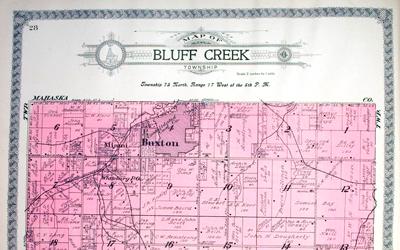
Description
This atlas and plat map book of Monroe County, Iowa, was compiled and published by Geo. A. Ogle & Co. in 1919 and funded by the federal government. This image shows a plat map of Bluff Creek Township and Buxton. The township was divided into sections and the owners of…
Buxton Wonders Baseball Team, 1915
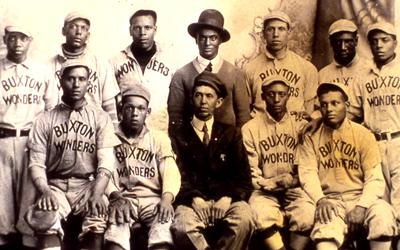
Description
The Buxton Wonders Baseball Team was partially sponsored by the Consolidation Coal Company through the donation of land to play on, building bleachers and even paying for uniforms for this traveling team. It is reported that this team always had both African-American…
Interview of Paul Wilson, Born in Buxton, May 13, 1992
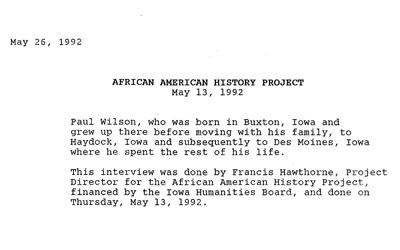
Description
This transcribed interview is of Paul Wilson, who was born in Buxton, Iowa, and grew up in the town. He then moved with his family, to Haydock, Iowa, and subsequently, to Des Moines, Iowa, where he spent the rest of his life. This interview was done in 1992 by Francis…
“Back to Buxton,” July 1, 2009

Description
This article by Eula Biss, entitled “Back to Buxton,” was published in 2009 by the Project on Rhetoric of Inquiry at the University of Iowa. The article focuses on the general components of Buxton, Iowa, featuring its remarkable reputation as being a town where blacks…
Aftermath of Explosion in Buxton’s #12 Mine, Date Unknown
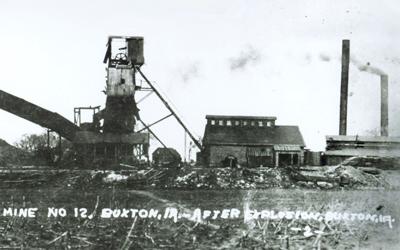
Description
In 1914, an explosion at mine #12 in Buxton led to the shutdown of that mine. Coal dust is highly flammable, and explosions were not uncommon. There is no record of anyone being hurt in the explosion since it happened after the mine closed for the day. The Consolidation Coal…
“Buxton Review” in the Iowa State Bystander, June 26, 1914
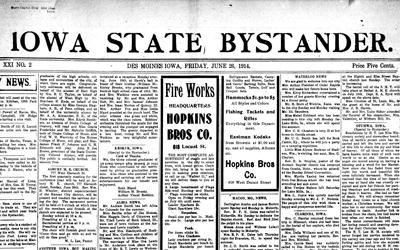
Description
This brief article about Buxton was published in the Iowa State Bystander on June 26, 1914. The article included parts about how a Buxton resident was glad that the coal mines have resumed work after several months. The lack of work has impacted community…
“As I Remember” by Minnie London, 1940
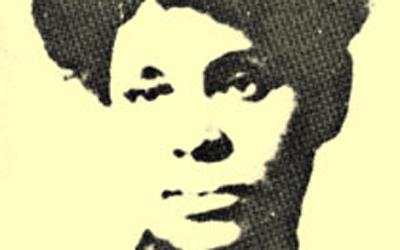
Description
This 1940 article was written by Minnie London, who first moved to Muchakinock as a bride and then to Buxton a few years later. London writes of her life as a coal miner’s wife including scheduling time to place orders with the company store, how people from many states…
Buxton: Work and Racial Equality in a Coal Mining Community, 1987
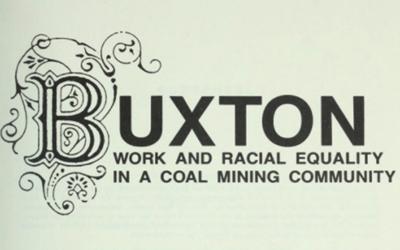
Description
Professor, researcher and author Dorothy Schwieder published "Buxton: Work and Racial Equality in a Coal Mining Community" in 1987. The first excerpt from this source is a table showing the annual income of selected workers in Buxton in 1914. It shows how lucrative jobs…
Additional Resources:
- Images of America: Lost Buxton by Rachelle Chase
This recent publication is loaded with rich images and meaningful quotes from dozens of Buxton citizens. The author synthesizes many sources to concisely tell the story of Buxton with meaningful details. - Buxton: Work and Racial Equality in a Coal Mining Community by Dorothy Schwieder
Professor, researcher and author Dorothy Schwieder provides details and explanations of many causes and effects of the formation and decline of Buxton. - CRI News Package: Home from Buxton, Iowa
This two-minute video tours a house from Buxton that was moved to Oskaloosa around the 1920s, and then was moved again to the Nelson Pioneer Farm during October 2008. - "Searching for Buxton" Documentary (Part One and Part Two)
A young African-American goes searching for his family's past in a long-disappeared Iowa coal mining town and discovers that much of the prosperity and goodwill his relatives enjoyed nearly a century ago is elusive today. Narrated by Simon Estes. - Reclaiming Iowa’s Abandoned Coal Mine Lands
This eight-minute Iowa Outdoors video focuses on Iowa's coal mines. A century ago, southern Iowa was home to hundreds of surface coal mines. As the coal boom died so did the companies that mined for it, leaving those mines abandoned and open to the elements. Today, decades after the industry died, efforts slowly continue to clean up the deserted mines and reclaim the ground that was once rich with coal. - "Editor's Observations" from the Iowa State Bystander
This October 29, 1909, newspaper article by John Lay Thompson, editor of the Iowa State Bystander, describes the success of African-Americans in Buxton, Iowa. During an era of Jim Crow laws in the South, those who were recruited from Virginia to come and work for Consolidation Coal Company experienced a far different reality in Buxton than they had in Virginia. In his editor’s column, Thompson writes about the demographics, businesses, prominent citizens and services located in Buxton, Iowa, in or around 1909. - "The Buxton Souvenir Number" from the Iowa State Bystander
This additional resource includes eight newspaper pages of photos and articles about Buxton that were published in the Iowa State Bystander on December 6, 1907. - Additional Buxton Photographs from the State Historical Society of Iowa
Iowa Core Social Studies Standards (2nd Grade)
Listed below are the Iowa Core Social Studies content anchor standards that are best reflected in this source set. The content standards applied to this set are elementary-age level and encompass the key disciplines that make up social studies for 2nd grade students.
| No. | Standard Description |
| SS.2.7. | Explain how people from different groups work through conflict when solving a community problem. |
| SS.2.10. | Determine effective strategies for solving particular community problems. |
| SS.2.12. | Identify how people use natural resources to produce goods and services. |
| SS.2.16. | Using maps, globes, and other simple geographic models, evaluate routes for people or goods that consider environmental characteristics. |
| SS.2.17. | Explain how environmental characteristics impact the location of particular places |
| SS.2.18. | Describe how the choices people make impact local and distant environments |
| SS.2.20. | Determine the influence of particular individuals and groups who have shaped significant historical change. |
| SS.2.24 | Describe the intended and unintended consequences of using Iowa’s natural resources. |